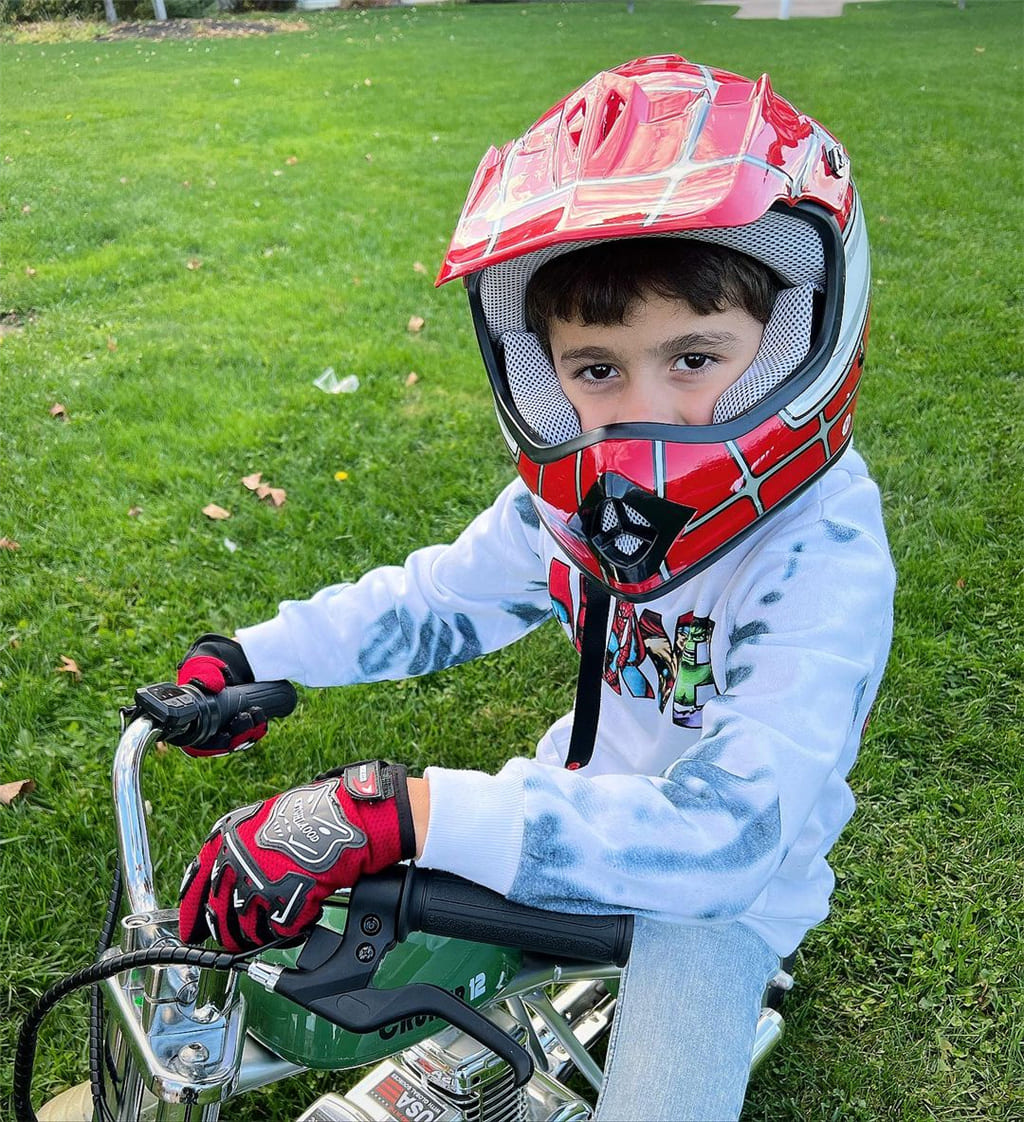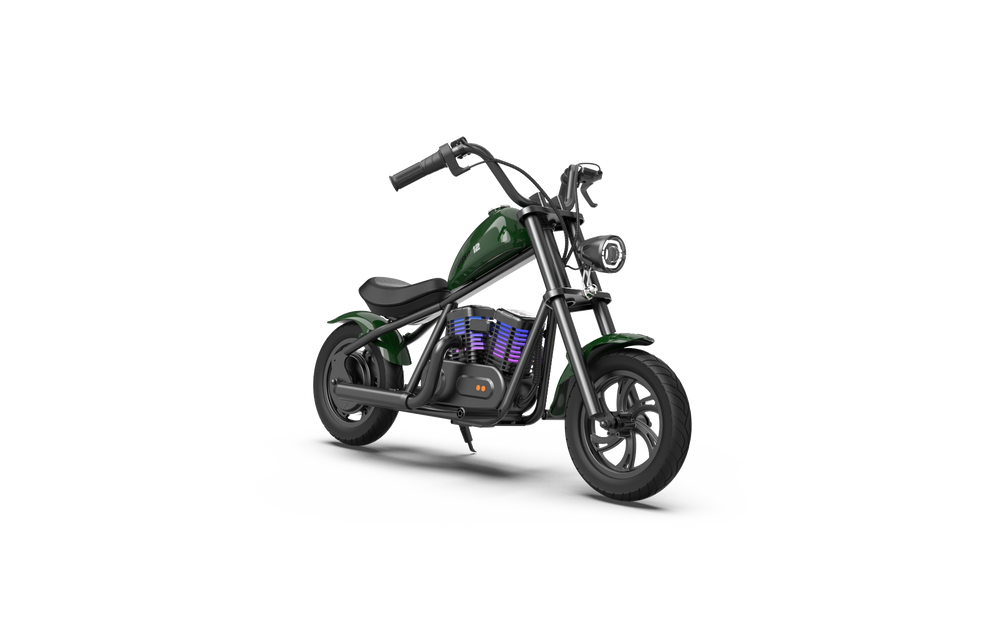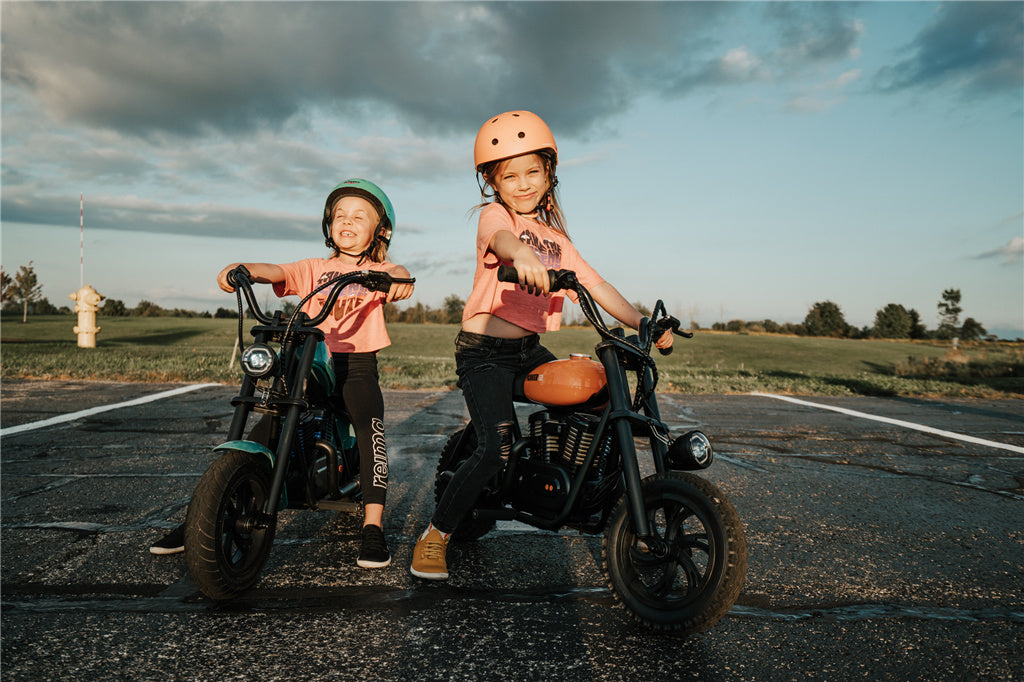Imagine feeling the wind whip through your hair, the sun warming your back and the adrenaline-pumping thrill of zooming down a mini chopper motorcycle for adventure and independence! However, with great power (in this case speed) comes great responsibility. Our youngest riders should never let excitement overshadow safety concerns, especially regarding helmets - one of the most integral safety gear items available to bikers today. In this guide we explore one of these essential items of protective equipment in great detail: helmets.
Why Helmets? The Hard Facts

Helmet safety can be defined in one simple yet profound word: protection. Helmets serve as the first line of defense between your child's head and outside influences such as hard pavement, passing objects or wind. Their design involves materials engineered to absorb impact energy and disperse it evenly over time thereby decreasing risks of serious head injuries.
Helms are designed to soften impacts in various ways. An outer shell, typically constructed of hard materials such as polycarbonate, absorbs most of the impact before dissipating its force over a larger area. Underneath this, dense foam absorbs energy before it can reach the head - this dual-action system plays a crucial role in preventing or significantly lessening traumatic brain injuries (TBIs), which can have severe long-term repercussions for children's health and wellbeing.
Helmets provide more than just protection from impacts; they also shield the skull from punctures, prevent skin abrasions and help avoid face and eye injuries when equipped with a visor. Furthermore, bright colors or reflective materials enhance visibility making your child more visible to other road users thus decreasing risk.
Laws and Regulations: Not Just a Suggestion
Helmet laws across nations and states recognize helmets as lifesaving gear, with each nation and state mandating that their citizens wear one when riding motorcycles. Studies have repeatedly proven this fact; helmet use dramatically decreases risks of head injuries and fatalities in motorcycle accidents; many regions have since implemented stringent requirements mandating helmet usage by all riders regardless of age.
Enforcement of these laws is designed not to inconvenience riders but rather protect them. Compliance is key not only for avoiding legal penalties but more importantly to securing lives. For children at increased developmental risk, helmet regulations are even stricter; many locations require specially-made child-specific helmets which fit smaller heads securely while offering appropriate levels of protection for young riders.
Education your child on the importance of adhering to laws can build responsibility and awareness; it goes beyond simply following rules; it is about realizing the value of one's life and safety on the road.
Choosing the Right Helmet: More Than Just a Fit
Picking the right helmet is akin to choosing the best shield in battle. It needs to be more than just a good fit—it has to meet safety standards (look for DOT, SNELL, or ECE certifications), be comfortable enough for long rides, and, let's be honest, it has to look cool (we know that matters to the kids). Here's what to consider:
- Size and Fit: A helmet should fit snugly but not too tight. It shouldn't wobble or pinch.
- Type: Full-face helmets offer the most protection, including the face and jaw.
- Ventilation: Good airflow keeps your child comfortable and focused.
- Visibility: Clear visors without scratches ensure good road visibility.
For example, the two children's helmets launched by HYPER GOGO are very suitable for children:
GuardianRide Helmet: A modern safety helmet designed specifically for riding, using advanced materials and technology to ensure the rider is protected.
Retro Helmet: Featuring a retro design, sizes range from 22.1-23.6 inches. It's designed to combine style and safety for riders who prefer a classic look.
Establish Helmet Habits Early
Starting young is key when it comes to instilling helmet habits. As soon as children understand and accept wearing a helmet as part of riding, the more deeply this practice becomes part of their routine - so much so that just putting one on becomes automatic in much the same way fastening seatbelts in a car is done automatically.
Implementing this habit begins with simple steps, like making selecting a helmet an exciting event for your child. Encouraging them to pick out one with designs they love while meeting safety standards gives them ownership over their helmet and promotes positive associations between it and them.
Consistency is also key. No matter how short or safe a ride seems to be, starting out each ride by wearing a helmet reinforces its importance and becomes part of riding ritual. Parents and guardians can set an example by always wearing helmets themselves when riding to reinforce this behavior through action instead of words alone.
Follow-up Reads: Fun + Educational Toys = Happy Children
Overcoming Resistance: Yes, They'll Thank You Later
Resistance From Children Is Common Overcoming resistance from kids as they grow older and start looking for greater independence can be a source of frustration. Reasons can range from discomfort, peer pressure or simply not liking the look of their helmet; overcoming this resistance requires understanding, firmness and often creativity from us all!
Addressing discomfort is easy: just ensure your helmet fits well, is not too heavy, and provides sufficient ventilation. A poorly fitting helmet can become a source of significant resistance; thus taking time to find one suitable is paramount.
Peer pressure and the desire to "look cool" can be more difficult to navigate than usual, making the search for helmets that meet both safety standards while meeting personal style preferences a difficult process. Luckily, the market offers plenty of choices such as those featuring vibrant graphics or those inspired by professional racing gear; all designed with style in mind!
Our pick

HYPER GOGO Cruiser 12 Plus
Safety Over Style, Always
In life's adventures on two wheels, safety must always come first. While it can be tempting to eschew wearing a stylish helmet in favor of more freedom or leave one at home for aesthetic reasons, we should never compromise safety for style as helmets save lives and must remain part of everyday riding experience.
Style doesn't need to come at the cost of safety; today's market offers numerous helmet options that combine style and protection without compromising either one. Brands recognize this challenge of appealing to younger audiences by creating designs that meet both compliance standards and are appealing.
However, when forced to choose between helmets that prioritize style over safety and ones that offer superior protection for whatever reason, always choose the latter option. Accidents don't discriminate based on how attractive or appealing a helmet may look - this is what truly determines its value as protection against impacts to the head.
Riding into the Sunset—Safely
As young riders rev their engines and take off into the sunset, their journey should always start by donning a helmet. This simple yet profound act sets the foundation for a riding experience that prioritizes safety above all; this commitment ensures that the joy and freedom of riding are never eclipsed by preventable risks.
Promoting safe riding practices, such as wearing helmets regularly, involves more than simply following rules: it requires cultivating a culture of safety that acknowledges both the inherent risks associated with cycling and any trip taken; every ride deserves equal precaution and consideration from riders and authorities alike.
Parents and guardians bear a tremendous amount of responsibility when it comes to teaching, guiding and sometimes enforcing safety practices. Being role models who demonstrate the significance of safety gear through actions and choices. Talking with young riders about why certain rules exist so they understand they're there not just to restrict fun; rather they ensure many more rides in the future.

Your Role in the Safety Saga
Your Role in Safety At the core of every young rider's journey is an ecosystem of support, guidance, and education provided by those they care for - you are an instrumental figure in their lives as a parent, guardian or caregiver - providing them with support, guidance and education when it comes to riding mini chopper motorcycles safely. Your approach to safety sets a benchmark that sets their attitude and behavior on the road.
Educator and Enforcer: Your role starts with education - teaching young riders the value of wearing helmets and adhering to safety practices each time they ride - as part of an ongoing dialogue that develops as they grow older and gain experience on the road. Alongside education, your role also involves enforcement: making helmets mandatory no matter the circumstances.
Role Model: Children learn by example and when they see you wearing a helmet and using safe riding techniques consistently, they may follow in your footsteps and adopt these habits themselves. Your commitment to safety through actions speaks louder than words - by serving as a visible role model you reinforce that safety should always be considered an imperative regardless of age or experience level.
Support System: Your role extends beyond simply setting rules and setting an example; it includes also being there as a support system for them, listening to any concerns that they might have with regards to comfort, peer pressure or anything else that may make them hesitate to wear a helmet. Finding solutions together such as finding stylish helmets which also meet safety standards or discussing strategies on how to positively address peer pressure can all help make up this complex equation.
Advocating: Advocating for safe riding practices extends far beyond your immediate family. You can advocate for safety across communities by attending safety workshops, advocating for riding practices that prioritize safety in your area or simply sharing knowledge and experiences with other parents and riders - your advocacy helps foster an environment in which safety is valued and promoted.
Your Role Is To Protect Their Future: As their protector, your role is ultimately to safeguard their future. By encouraging safe riding habits including wearing helmets on every ride, not only are you safeguarding them from potential harm today; you are setting them up for years of enjoyable and safe adventures on the road - assuring their adventures don't cost them their health and wellbeing!
Your involvement in your child's riding experience is absolutely key; it requires an amalgam of education, enforcement, support, and advocacy on his/her behalf. By playing an active part in safety initiatives you help create a more conducive riding environment not just for yourself and your own child but also the whole community of young riders - one helmet at a time ensuring their journey on two wheels remains as safe and exciting as it can possibly be!
Conclusion
A helmet is a basic safety requirement when your child rides the HYPER GOGO kids motorcycle. By choosing the right helmet and instilling good practices for their head protection needs, you can not only keep your children safe, but also protect their heads. You can also allow them to enjoy the journey worry-free. Cheers to many safe and thrilling adventures along the way!
FAQs
Can a helmet really make a difference?
Absolutely. Helmets play an invaluable role in protecting riders against serious and life-altering head injuries - some of the most devastating to occur on any bike rider's journey.
How often should helmets be replaced?
Helmets should be checked every year or two to be safe for continued use.
Are there helmets designed specifically for children?
Yes, specifically adapted helmets exist that meet this need.













